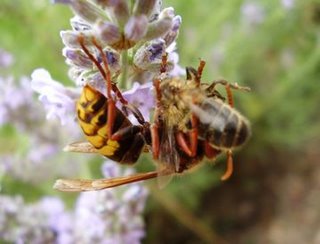They aren't wasps though, they are bees - solitary bees with some interesting habits.
They are called wool carder bees because the females collect the hairs from certain plants in order to line their nest holes. They shave the plant hairs off using their jaws then collect them into balls before flying back to their burrow.
This reminded people of carding wool - sorting and detangling and collecting wool into hanks which was something that needed to be done before wool could be spun- hence the name 'wool carder bee' aka Anthidium manicatum.
Once the burrow is lined, and cells created from the plant hairs, they lay their eggs and place pollen inside the burrow as a food source for the larvae. Then they seal the burrow with small stones and soil.
 I don't have any photos of the bees collecting the hairs- lavendar isn't hairy and there weren't any hairy plants around. These bees were photographed on a lavendar bush in the centre of Nice so i'm not sure where they find hairy plants like lamb's ear and mullein in the city.
I don't have any photos of the bees collecting the hairs- lavendar isn't hairy and there weren't any hairy plants around. These bees were photographed on a lavendar bush in the centre of Nice so i'm not sure where they find hairy plants like lamb's ear and mullein in the city.

 It looks like i have only managed to photograph female wool carders -or at least these are the ones i can definitely identify- its probable that soem of the larger ones are males but their distinctive barbs on their abdomen and slightly different body patterns aren't clearly visible.
It looks like i have only managed to photograph female wool carders -or at least these are the ones i can definitely identify- its probable that soem of the larger ones are males but their distinctive barbs on their abdomen and slightly different body patterns aren't clearly visible.Certainly there were some definite males flying around at the time becuase they have quite agressive behaviour towards their own species. They would grapple and attempt to mate with the pollen collecting females or dive bomb bee couples in an attempt to dislodge the other male.
They weren't bothered by me taking photos though.

This is a European hornet Vespa crabro killing a honey bee - I'm posting the photo for comparison with the wool carders.
The hornet's red legs are quite noticeable and there is also reddish hair on the hornet's back
I didn't have a great deal of time between spotting the hornet and it flying away with its prey firmly grasped in its legs.
I was amazed at how easily it managed the weight of the bee. I knew hornets [and wasps] hunted bugs and flies but somehow i didn't expect them to hunt bees as well.
They feed the larvae on chewed up insect meat -so this will be the fate of the bee

Technorati Tags:
macro
photos
bee
wool carder
Anthidium manicatum
hornet
Vespa crabro











1 comment:
Wow! These are gorgeous! I was wondering if these where taken near dusk...around my area in PA, USA big bumble bees will "fall asleep" as it gets dark right in the middle of gathering pollen. Very odd...but interesting.
Post a Comment